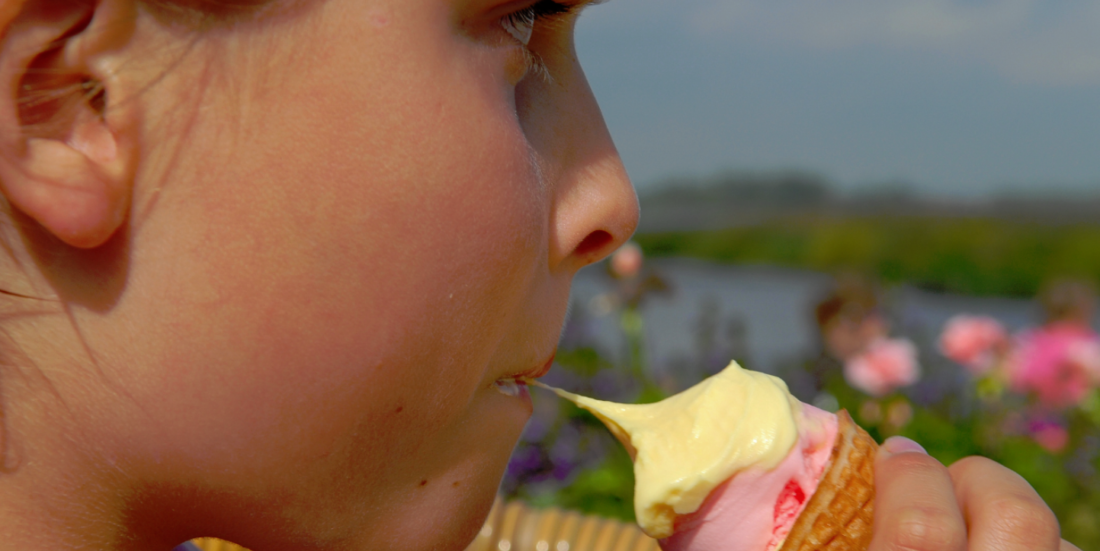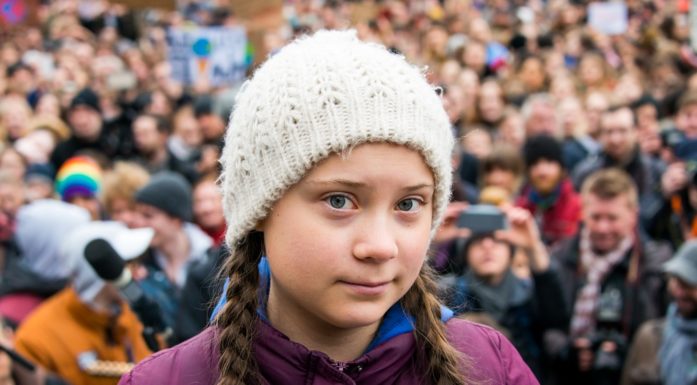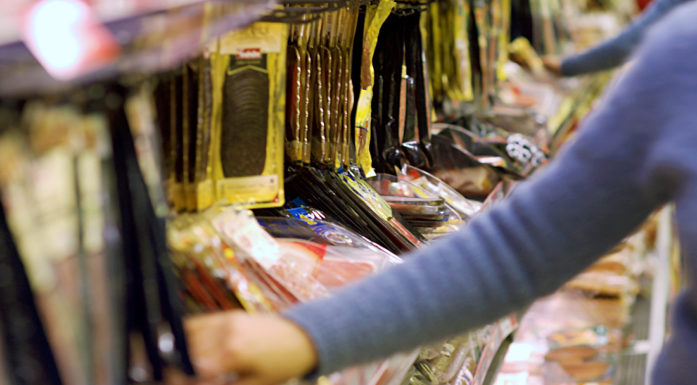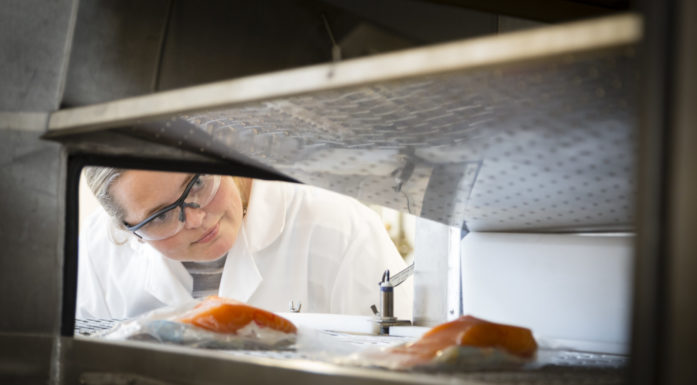Norwegian researchers are developing ice-cold eco-technology
Thanks to toxin-free technology that also saves energy, Norwegians can eat their ice cream without worrying about the climate.
SINTEF energy researcher Ingrid Camilla Claussen can guarantee that Norwegian ice cream is more eco-friendly than most. One of the reasons is that artificial and powerful greenhouse gas refrigerants have been replaced by natural media. Soon this will also be the case for the raw materials from which our ice cream is made.
Combining ventilation with refrigeration
The fact is that the freezers and cold counters used to keep food cold in supermarkets are now using CO2 as a refrigerant instead of hydrofluorocarbons, which are much more damaging to the environment. When the weather is cold, surplus heat is sent from the refrigeration to the ventilation system to help keep the building warm.
“By combining food store ventilation and refrigeration systems, we can show that it’s possible to make energy savings of about 30 per cent”, says Claussen, who is a Research Manager at SINTEF. “We have demonstrated this in several Norwegian stores”, she says.
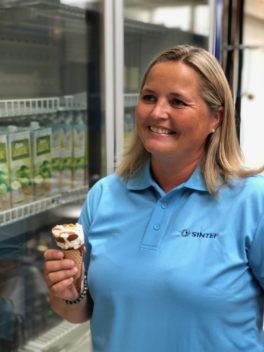
Loves ice cream: Researcher Ingrid Camilla Claussen in SINTEF leads the project SuperSmart. Photo: SINTEF.
Dairy makes energy consumption savings equivalent to 250 households
The Tine dairy concern is the first in Norway planning to use surplus heat from its milk and dairy product refrigeration system as heat input to other parts of its production process. Tine’s new dairy in Bergen will demand 40 per cent less energy for every litre of milk it produces. In total, these energy savings are equivalent to the consumption of 250 households. Construction work started last autumn and the dairy will be ready for production towards the end of 2019. The project is supported by green energy
funders Enova.
SINTEF is behind the system that combines refrigeration and the exploitation of surplus heat. Tine is a project partner in the HighEFF Centre for Environment-Friendly Energy Research (CEER), and commissioned SINTEF to find the best solution. In this way the results from the construction and operation of the new refrigeration technology will benefit all HighEFF partners.
EU ban fuelled Norwegian innovation
Large refrigeration plants and air conditioning systems currently use refrigerants that make a major contribution to climate change. Initially, hydrofluorocarbons (HFCs) were used to replace other halogenated hydrocarbons, such as chlorofluorocarbons, that deplete the ozone layer and which have been banned for some time.
However, in order to mitigate climate change, the EU has decided to phase out the use of those hydrofluorocarbons that contribute most to the problem. Since 2015, it has been prohibited to build new plant using refrigerants of this type, and since 2017, HFCs have been banned from the air conditioning systems installed in road vehicles.
When the EU banned the use of hydrofluorocarbons in refrigerators, freezers and air conditioning systems, researchers in Trondheim hurried to their labs to speed up development of their new approach to refrigeration using CO2. SINTEF and NTNU had already accumulated many decades of experience in the use of CO2 as a refrigerant.
This is SuperSmart:
SuperSmart is an EU project that will help more food stores install more energy efficient and environmentally friendly refrigeration systems, including utilization of surplus heat from the refrigeration plant.
SINTEF is a project coordinator with two technical universities, two research institutes, two companies and an international organization for cooling from eight countries as partners.
The project is supported by the EU Horizon 2020 program and is being implemented in the period 2015-2019.
SuperSmart is an EU project that will help more food stores install more energy efficient and environmentally friendly refrigeration systems, including utilization of surplus heat from the refrigeration plant.
SINTEF is a project coordinator with two technical universities, two research institutes, two companies and an international organization for cooling from eight countries as partners.
The project is supported by the EU Horizon 2020 program and is being implemented in the period 2015-2019.
An important part of the project is dissemination and a number of training courses have been held for employees in retail chains and seminars with stakeholders as suppliers of refrigeration solutions and consultants.
Used in stores all over Scandinavia
In Scandinavia today, all refrigeration systems installed in stores run on so-called natural refrigerants such as CO2, ammonia, butane and propane. CO2 is the most commonly used. The supermarket chains Rema 1000, Coop and Norgesgruppen all use systems of this type.
More and more stores are combining refrigeration with the use of a heat pump so that heat can be conserved by heating the air in the ventilation system. In Rema 1000’s store in Kroppanmarka in Trondheim, surplus heat is pumped into underground storage in summer so that it can be used in winter. The Kiwi chain is planning a system in which surplus heat from refrigeration is used to heat local flats and offices.
The time has now come to convince the rest of Europe.
Educating store owners to be more eco-friendly and energy-efficient
For three years now, SINTEF has been heading a major European project called Supersmart. Partners from eight countries are preparing the background material to help the developers of new stores design refrigeration systems that are as eco-friendly and energy-efficient as possible. They will also be showing owners of existing stores how they can make their outlets more eco-friendly and energy-efficient by replacing their current systems.
“We’re telling people that this is an effective technology so that they can make the right investments”, says Claussen, who is coordinator for this particular EU Horizon 2020 project.
Not so easy in southern Europe
While CO2 is the preferred option in Scandinavia, store owners in southern Europe are more sceptical.
“There are high levels of scepticism to CO2 technologies in hot-temperature countries, due in part to high investment costs and issues linked to making these systems as energy-efficient as conventional ones.
SINTEF and NTNU have taken up the challenge and are now working with a number of organisations to improve the efficiency of CO2-based refrigeration systems in tropical regions. As part of the EU project H2020 MULTIPACK, they will be testing integrated systems in stores and hotels in Italy and Portugal. The project INDEE has involved a collaboration between Norwegian researchers, the Norwegian embassy in India, and the University of Madras, resulting in the construction of a mini-version (pilot) system designed to test different operational parameters with the aim of identifying the best system for use in the tropics. The tests were carried out in Europe and India.
Eco-labelling will attract more customers
“The idea is that eco-labelling will boost awareness of eco-friendly refrigeration systems”, says Claussen. “They cost more than traditional systems, but the stores will get their investment back by attracting more customers”, she says.
Claussen will be presenting the results from the project, as well as eco-friendly refrigeration, during the major political and business forum being held this week in the Arendal, Norway. (Arendalsuka).
